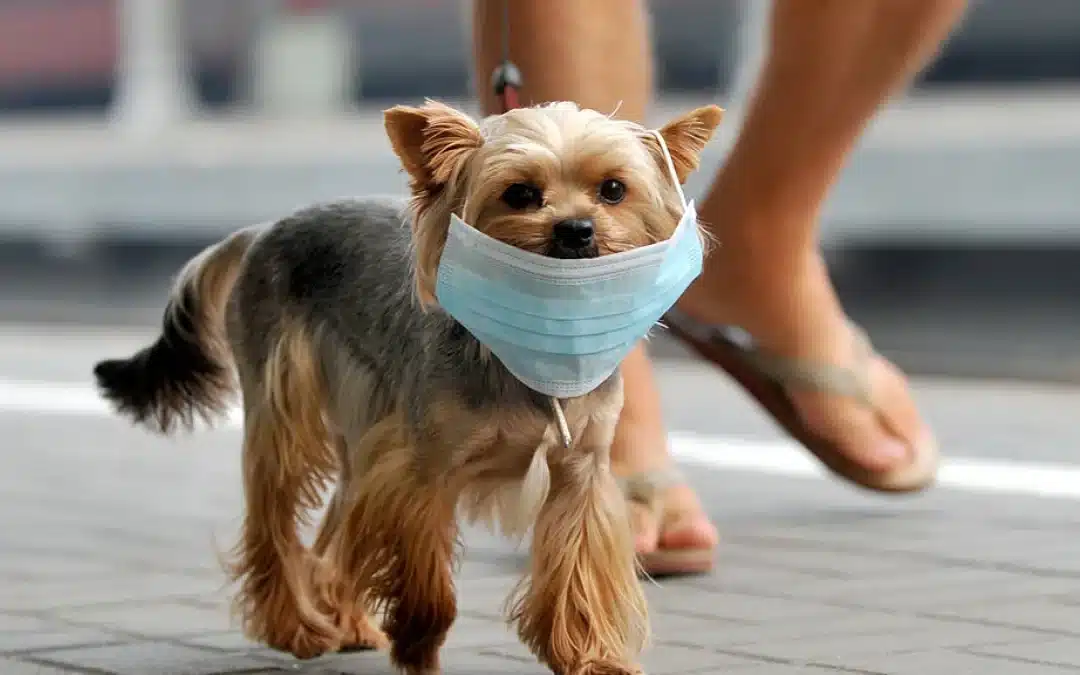As wildfires continue to spread in Canada, the smoke and haze have significantly impacted NYC residents. Once again an air quality alert was issued for Staten Island. Both adults and children have been advised to limit their outdoor activities, reducing their exposure to airborne particles. But pets can also suffer from smoke inhalation, and in many cases, their systems are more severely impacted than ours.
Happy At Home knows that many owners worry about their pets during environmental crises. In this article, we’ll look at a few things you should know about protecting your pet from wildfire smoke.
 Can dogs die from smoke inhalation?
Can dogs die from smoke inhalation?
First, we’ve got some good news: most dogs who need medical care due to smoke inhalation will survive. However, your dog’s outlook might be less positive if:
- They present with neurological symptoms (usually due to oxygen shortage)
- They’ve sustained significant burns
- They begin to decline after hospitalization
Clearly, smoke inhalation can be serious and life-threatening for dogs. In fact, it’s considered a major cause of death in animals.
What happens if my dog inhales smoke?
Smoke inhalation harms your dog in several ways. Let’s look at a couple of the major problems that happen when your dog breathes in wildfire smoke.
Irritated airways
Your dog’s airways are sensitive, and the particles in smoke can easily injure them. Thermal injury from the smoke’s heat is also a possibility. Unfortunately, this type of damage often doesn’t always cause external symptoms – at least, not right away. They may appear within 2 to 3 days of exposure, if they aren’t immediately present.
Carbon monoxide poisoning
Carbon monoxide found in smoky air can cause your pet’s cells to be deprived of oxygen. A dog suffering from carbon monoxide poisoning may display these five common symptoms:
- Reddened gum tissue
- Breathing trouble
- Lethargy
- Vomiting
- Clumsiness
However, other symptoms are also possible. You might even notice a sudden change in behavior – your dog may start acting anxious or aggressive for no apparent reason. They may even fall over if their exposure is severe enough.
What air quality is unsafe for dogs?
AirNow is an air quality database maintained by the government. AirNow issues a color and number to indicate the current air quality. For example, an air quality between 0 to 50 is considered good and assigned a color of green. Air quality between 151 and 200 is considered unhealthy and coded as red. Your pet’s health may be at risk when the air quality is rated above 150. If your pet is especially sensitive to smoke due to age, health or genetics, that number might be lower.
What symptoms of smoke inhalation should I look for in my dog?
There are many possible symptoms of smoke inhalation in dogs, but here are some of the most common signs of trouble to watch for.
- Squinting, swelling, or redness in eyes
- Nasal discharge or blisters
- Signs of carbon monoxide poisoning, as discussed above
- Coughing or difficulty breathing
Call your vet to report symptoms and determine the best course of action.
How should I treat my dog for smoke inhalation symptoms?
Your dog needs oxygen therapy, and probably other interventions too, at your veterinarian’s office. However, until you can get to the vet’s, make sure to remove your dog from smoky air as quickly as possible. A mask such as the K9 mask
How can I prevent my dog from inhaling smoke?
The best course of action is to keep your dog indoors when there’s smoke in the air. Besides putting a mask on your dog, this is the only way to limit the smoke they breathe in.
Since smoky air can be harder to breathe, try to limit your dog’s activity level when wildfire smoke is rampant. The less heavy breathing they do, the fewer particles your dog will inhale. Keep your dog properly hydrated so that their airways don’t become dried out.
While keeping your pet indoors can be challenging, it’s worth doing to protect your dog’s health. Use puppy pads as necessary and look for creative ways to provide your dog with light movement (not strenuous exercise). Food puzzles can be a great indoor way to keep your dog busy and entertained for a while. Always remember, your pet relies on you to make the best decisions for their wellbeing.

If you’re looking for someone who’ll go bananas every time they see your dog or cat, knows them so well they notice one hair out of place, speaks their language, knows their favorite treat AND movie and most of all become their second favorite human in the whole world, then you’ve found the right person! Lisa resides in Westerleigh and is a Dogtec Certified Dog Walker, NYC Certified in Animal Care and Handling, FEMA Animals in Disasters Certified, a Trap-Neuter-Return (TNR) and Feral Colony Care Specialist and Red Cross Pet First Aid Certified.

